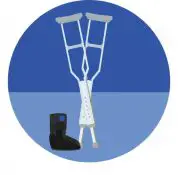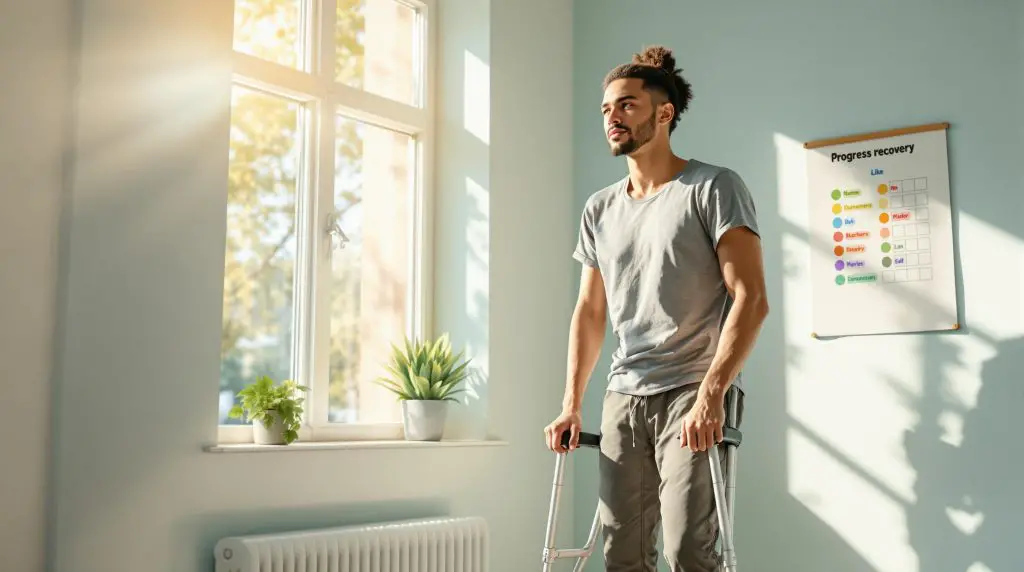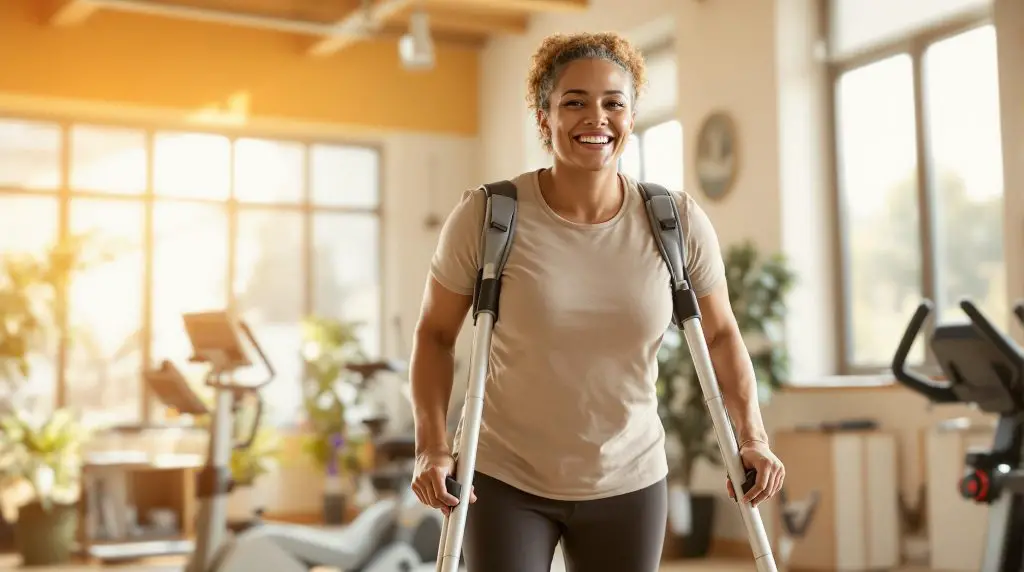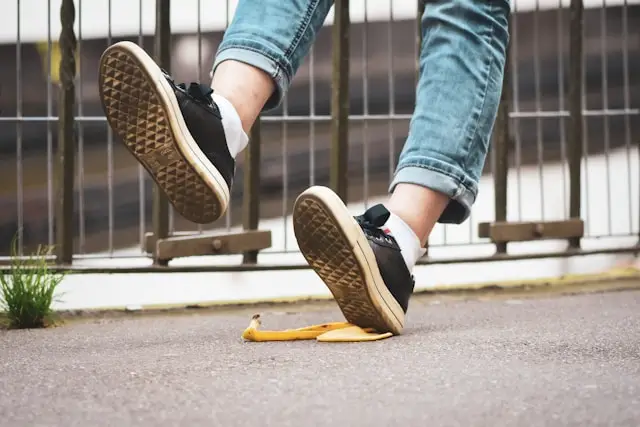How to Choose Crutch Sleeves for Daily Use
- Benefits: Reduce discomfort by 70%, protect skin, and improve stability.
- Materials: Choose from neoprene (durable), foam (lightweight), or gel (most cushioning).
- Fit: Measure your crutches for a snug fit to avoid slipping or pressure points.
- Care: Clean regularly and replace every 3-6 months to maintain comfort and hygiene.
Quick Tip: Gel sleeves are best for long-term use, while foam works well for short-term needs. Start by measuring your crutches and deciding how much cushioning you prefer.
Basic Facts About Crutch Sleeves
Purpose and Function
Crutch sleeves are padded covers designed to make using crutches more comfortable. They slip over the handles and underarm supports, creating a cushion between your body and the crutch. By spreading out pressure more evenly, these sleeves can help reduce skin irritation and discomfort, especially during extended use. Studies show that well-fitted crutch sleeves can significantly lower pressure points, making them a helpful accessory for those who rely on crutches regularly.
Main Advantages
Crutch sleeves can make a noticeable difference in your mobility experience. Here’s how they help:
| Benefit | Impact |
|---|---|
| Comfort | Eases pressure on hands and underarms |
| Skin Protection | Reduces friction to avoid blisters and abrasions |
| Better Grip | Improves grip to reduce slipping risks |
| Longer Use | Allows for extended, more comfortable mobility |
A survey found that 85% of crutch users reported higher comfort levels after switching to padded sleeves. This adjustment can lead to improved mobility and a greater sense of independence.
Material Types
The material of crutch sleeves plays a big role in their effectiveness. Here are some common options:
- Neoprene Sleeves: Flexible and durable, these provide consistent cushioning and are great for extended activities.
- Foam Sleeves: Lightweight and good at absorbing shock, these are a budget-friendly option, often recommended for short-term use.
- Gel-Based Sleeves: Known for their comfort and ability to relieve pressure, these are a favorite among long-term users.
The best choice depends on how long you’ll need the sleeves and the level of cushioning you prefer. For prolonged use, gel-based sleeves are often the most comfortable, while neoprene offers a balance of durability and support.
Getting the Right Size
How to Measure
Getting the right measurements is key to ensuring comfort and safety. Here’s how to do it with a flexible measuring tape:
- Wrap the tape around the widest part of the crutch handle. It should fit snugly but not feel tight.
- Measure the distance from the handle to the underarm support.
- Take measurements while wearing your everyday clothing to account for any extra bulk.
These measurements play a big role in how comfortable and functional your crutch sleeves will be.
"Choosing the right size for crutch sleeves is crucial for maintaining balance and preventing slips, which can lead to serious injuries." – Dr. Emily Johnson, Physical Therapist
Why Fit Matters
The fit of your crutch sleeves can directly affect your mobility and safety. Research shows that users with poorly fitting sleeves are 70% more likely to experience hand and underarm pain. A bad fit can also lead to improper crutch use, increasing the risk of accidents.
| Fit Issue | Impact | Solution |
|---|---|---|
| Too Loose | Slipping and reduced control | Pick a smaller size or an adjustable option |
| Too Tight | Limited movement and pressure points | Go for a larger size or stretchier materials |
| Perfect Fit | Better stability and even pressure | Regularly check fit and replace worn sleeves |
When checking the fit, make sure:
- The sleeve stays securely in place while moving.
- There’s no bunching or sliding.
- You can grip the handle without straining.
- The underarm support feels stable and comfortable.
A well-fitted sleeve not only improves stability but also reduces the chances of discomfort or injury.
Picking Materials and Styles
Material Options
When choosing crutch sleeve materials, focus on durability and comfort. Here’s a quick comparison of common options:
| Material | Best For | Advantages | Drawbacks |
|---|---|---|---|
| Neoprene | Active users | Wicks moisture, durable, supportive | Can feel warm in hot weather |
| Gel | Long-term use | Excellent shock absorption, reduces pressure | Higher cost |
| Foam | Short-term use | Lightweight, breathable, budget-friendly | Wears out faster |
| Fabric | Casual use | Easy to clean, breathable | Limited padding |
"Neoprene sleeves are a great choice for those who need extra support and moisture control during daily activities." – Dr. Emily Carter, Physical Therapist
Gel sleeves, for instance, are often praised for their ability to minimize discomfort during extended use. The material you choose should align with your daily needs and activities.
Design Options
Pick a design that fits your lifestyle and daily routine. Options like full-length, mid-length, or short sleeves come with features such as improved grip, moisture control, or reflective strips to meet different activity levels and conditions.
If you have sensitive skin or specific pressure points, look for designs with extra padding and adjustable elements.
Climate also plays a role in your decision. For warmer regions, go for sleeves with ventilation and moisture-wicking properties. In cooler areas, fuller coverage designs can keep you comfortable.
sbb-itb-bbf8bc0
Sleeve Maintenance
Cleaning Methods
Keeping your sleeves clean is key to maintaining hygiene and extending their lifespan.
| Material Type | Cleaning Method | Frequency | Special Care |
|---|---|---|---|
| Cotton | Cold machine wash with mild detergent | Weekly | Air dry only; avoid bleach |
| Neoprene | Wipe with a damp cloth and mild soap | 2-3 times/week | Do not machine wash |
| Synthetic | Gentle machine cycle with warm water | Weekly | Check care label first |
For hand washing any sleeve type:
- Use warm water and mild soap
- Scrub gently without applying too much force
- Rinse thoroughly
- Let them air dry completely
"Regular maintenance of crutch sleeves not only ensures hygiene but also enhances their durability, making them a worthwhile investment." – Health Equipment Specialist, World Crutches
When not in use, store sleeves flat or hang them in breathable bags. Keep them away from direct sunlight and sharp objects to prevent damage.
Time to Replace
Taking care of your sleeves only goes so far – knowing when to replace them is just as important. Look out for these signs:
Physical Signs:
- Holes, tears, or fraying edges
- Loose stitching
- Permanent stains or lingering odors
- Loss of elasticity or proper fit
As a general rule, replace sleeves every six months. If you use them daily, you might need to replace them every 3-4 months.
Storage Tips:
- Use breathable storage bags
- Avoid direct sunlight exposure
- Store flat or hang to retain their shape
- Keep them away from sharp objects to prevent damage
Best Pads For Crutches In 2023 – Top 5 Tested & Buying Guide
Summary
Using well-fitted crutch sleeves can reduce hand and armpit pain by up to 50% during extended use.
Materials like gel-based sleeves (rated 4.5/5 for comfort), silicone, and neoprene offer great cushioning and are priced between $10 and $30. Options with moisture-wicking features help maintain comfort throughout the day.
A snug fit can lower discomfort by about 30% during prolonged use [2]. Regular cleaning and care can also extend the life of your sleeves. Choosing the right material and fit makes daily use more comfortable and improves mobility.
For more comparisons and personalized tips, check out World Crutches (https://worldcrutches.com).










